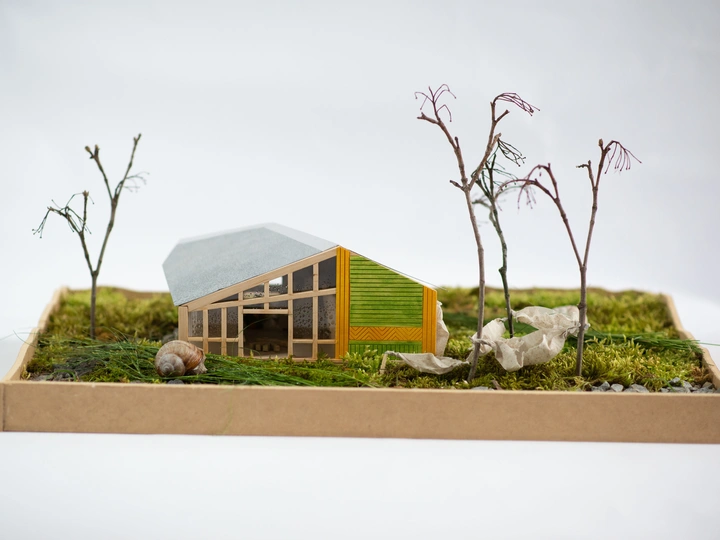Skhody

My name is Nikita Shulga, 17 years old, and I am from Kyiv, I graduated from the first year of architecture at the KhSA. Architecture has always been in my life, but I realized my passion for it only at the end of school. At that time I was interested in modernism and all its manifestations. I was fascinated by modernist ideas, forms, and the visual component, and I thought I would move in this direction until I started to actually work. Modernism, especially early modernism, does not involve the demonstration of cultural elements, it tends to aggressive globalization, and it is not very environmentally friendly, which I do not see a place for in my work. The path of perceiving myself as a Ukrainian, and in general a person as a unit of a specific society formed by cultural characteristics, lasted quite a long time, and it seems to have recently ended. In my work I concentrate on the study of color and shapes, their combinations, and functionalism, because I think these are important things. I love ornaments, but they are essentially outdated and useless, as they were based on mysticism rather than objective characteristics. Modern society is not guided by amulets and myths, but every color and shape has an impact on the human psyche, and their combinations can create certain feelings and emotions, which is also an architectural tool. If you change the function of the ornament from a guardian against evil forces to a catalyst for emotions, you can get something interesting. Speaking of function, for me everything that doesn't have it has no objective meaning, so every thing should ideally be multifunctional. An ornament cannot just be painted on top of a wall, it must either be a wall or not at all, this is its tectonicity. Every brickwork or a wall made of boards nailed together in different directions can be an ornament. First function, then aesthetics, except when aesthetics is the main function. From the inside to the outside.
The goal was to design an inexpensive, eco-friendly wooden frame house for refuges from war areas. In my case, the users were 4 students. Their main occupation is Zoom classes, and their additional activities include chatting with friends, playing games or instruments. The main ideas of the house were soundproofing, intimacy, and community. When working on the planning, I started from internal needs, but I also had certain limitations externally - there are 9 other houses on the site, one of them is particularly close, and 4 students will also live there, so the issue of intimacy and silence was at stake in the first place. The easiest way to fence off is a wall, which I formed from 4 living rooms of 6 m² each, and moved them a meter to the side so that everyone had a convenient exit and their own micro-yard. Two 4m² bathrooms, a 4m² winter garden, a 6m² kitchen, and a common space for communication, guests, parties, etc. grew between the wall and the neighbor. Each room has access to its own patio with a feeder for animals, which allows you to see something new and pleasant from the window every day, and a street curtain can close it all off from others. The wall of the common part of the house is made of glass and has a giant summer door that lets in space and light. The kitchen wall is made of glass blocks, which helps to save even more on lighting, and the house itself stands on stilts, minimizing interference with nature. All the rooms are like boxes under a common roof, which allows us to use their "lids" as storage or spaces. The window in the ceiling above the garden illuminates the far part of the house, gives the plants sunshine and the opportunity to watch the stars from the house. The façade of the house has two faces: a simple public face that everyone can see, and a complex private face that only 1 person can see. The ornament is tectonic, inspired by old Ukrainian wooden houses, and has inherent meanings that you don't have to know to feel something.